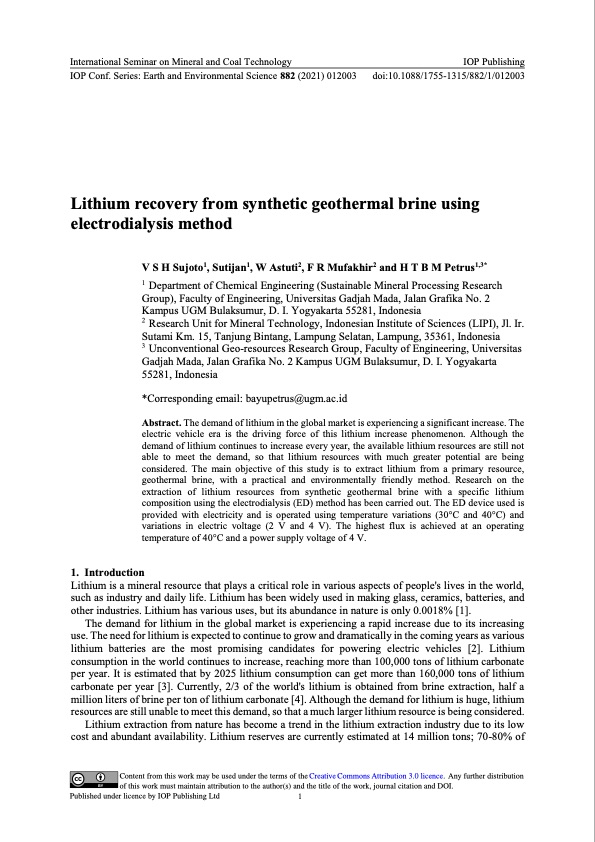
PDF Publication Title:
Text from PDF Page: 002
International Seminar on Mineral and Coal Technology IOP Publishing IOP Conf. Series: Earth and Environmental Science 882 (2021) 012003 doi:10.1088/1755-1315/882/1/012003 Lithium recovery from synthetic geothermal brine using electrodialysis method V S H Sujoto1, Sutijan1, W Astuti2, F R Mufakhir2 and H T B M Petrus1,3* 1 Department of Chemical Engineering (Sustainable Mineral Processing Research Group), Faculty of Engineering, Universitas Gadjah Mada, Jalan Grafika No. 2 Kampus UGM Bulaksumur, D. I. Yogyakarta 55281, Indonesia 2 Research Unit for Mineral Technology, Indonesian Institute of Sciences (LIPI), Jl. Ir. Sutami Km. 15, Tanjung Bintang, Lampung Selatan, Lampung, 35361, Indonesia 3 Unconventional Geo-resources Research Group, Faculty of Engineering, Universitas Gadjah Mada, Jalan Grafika No. 2 Kampus UGM Bulaksumur, D. I. Yogyakarta 55281, Indonesia *Corresponding email: bayupetrus@ugm.ac.id Abstract. The demand of lithium in the global market is experiencing a significant increase. The electric vehicle era is the driving force of this lithium increase phenomenon. Although the demand of lithium continues to increase every year, the available lithium resources are still not able to meet the demand, so that lithium resources with much greater potential are being considered. The main objective of this study is to extract lithium from a primary resource, geothermal brine, with a practical and environmentally friendly method. Research on the extraction of lithium resources from synthetic geothermal brine with a specific lithium composition using the electrodialysis (ED) method has been carried out. The ED device used is provided with electricity and is operated using temperature variations (30°C and 40°C) and variations in electric voltage (2 V and 4 V). The highest flux is achieved at an operating temperature of 40°C and a power supply voltage of 4 V. 1. Introduction Lithium is a mineral resource that plays a critical role in various aspects of people's lives in the world, such as industry and daily life. Lithium has been widely used in making glass, ceramics, batteries, and other industries. Lithium has various uses, but its abundance in nature is only 0.0018% [1]. The demand for lithium in the global market is experiencing a rapid increase due to its increasing use. The need for lithium is expected to continue to grow and dramatically in the coming years as various lithium batteries are the most promising candidates for powering electric vehicles [2]. Lithium consumption in the world continues to increase, reaching more than 100,000 tons of lithium carbonate per year. It is estimated that by 2025 lithium consumption can get more than 160,000 tons of lithium carbonate per year [3]. Currently, 2/3 of the world's lithium is obtained from brine extraction, half a million liters of brine per ton of lithium carbonate [4]. Although the demand for lithium is huge, lithium resources are still unable to meet this demand, so that a much larger lithium resource is being considered. Lithium extraction from nature has become a trend in the lithium extraction industry due to its low cost and abundant availability. Lithium reserves are currently estimated at 14 million tons; 70-80% of Content from this work may be used under the terms of the Creative Commons Attribution 3.0 licence. Any further distribution of this work must maintain attribution to the author(s) and the title of the work, journal citation and DOI. Published under licence by IOP Publishing Ltd 1PDF Image | Lithium recovery synthetic geothermal brine electrodialysis

PDF Search Title:
Lithium recovery synthetic geothermal brine electrodialysisOriginal File Name Searched:
lithium-from-brine-geothermal.pdfDIY PDF Search: Google It | Yahoo | Bing
Product and Development Focus for Infinity Turbine
ORC Waste Heat Turbine and ORC System Build Plans: All turbine plans are $10,000 each. This allows you to build a system and then consider licensing for production after you have completed and tested a unit.Redox Flow Battery Technology: With the advent of the new USA tax credits for producing and selling batteries ($35/kW) we are focussing on a simple flow battery using shipping containers as the modular electrolyte storage units with tax credits up to $140,000 per system. Our main focus is on the salt battery. This battery can be used for both thermal and electrical storage applications. We call it the Cogeneration Battery or Cogen Battery. One project is converting salt (brine) based water conditioners to simultaneously produce power. In addition, there are many opportunities to extract Lithium from brine (salt lakes, groundwater, and producer water).Salt water or brine are huge sources for lithium. Most of the worlds lithium is acquired from a brine source. It's even in seawater in a low concentration. Brine is also a byproduct of huge powerplants, which can now use that as an electrolyte and a huge flow battery (which allows storage at the source).We welcome any business and equipment inquiries, as well as licensing our turbines for manufacturing.| CONTACT TEL: 608-238-6001 Email: greg@infinityturbine.com | RSS | AMP |